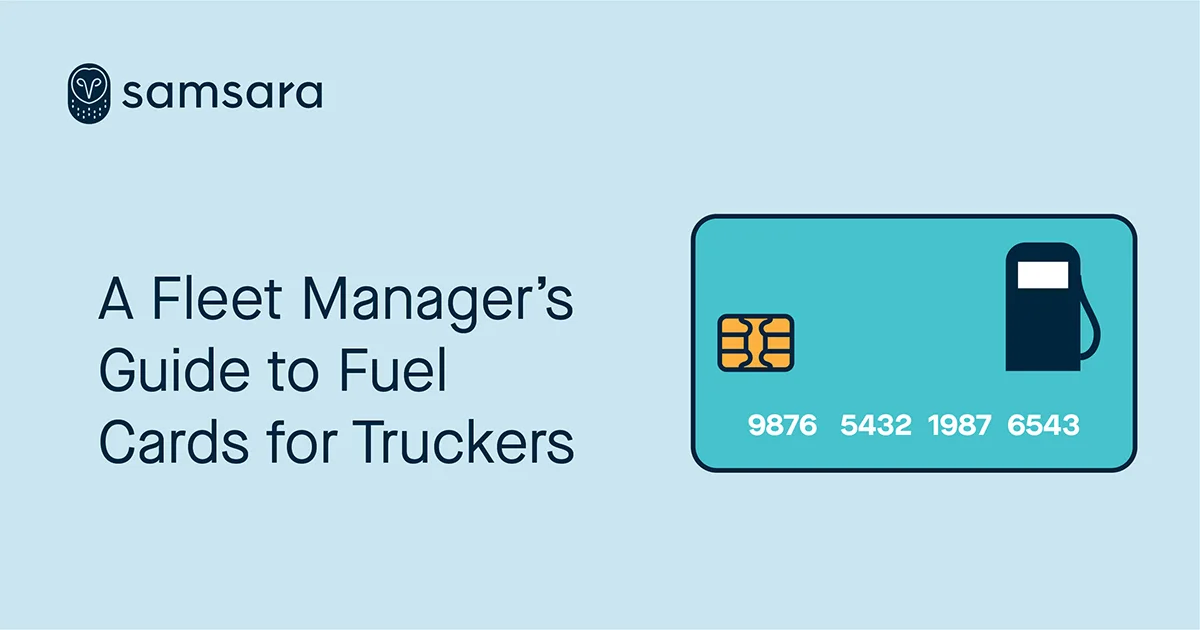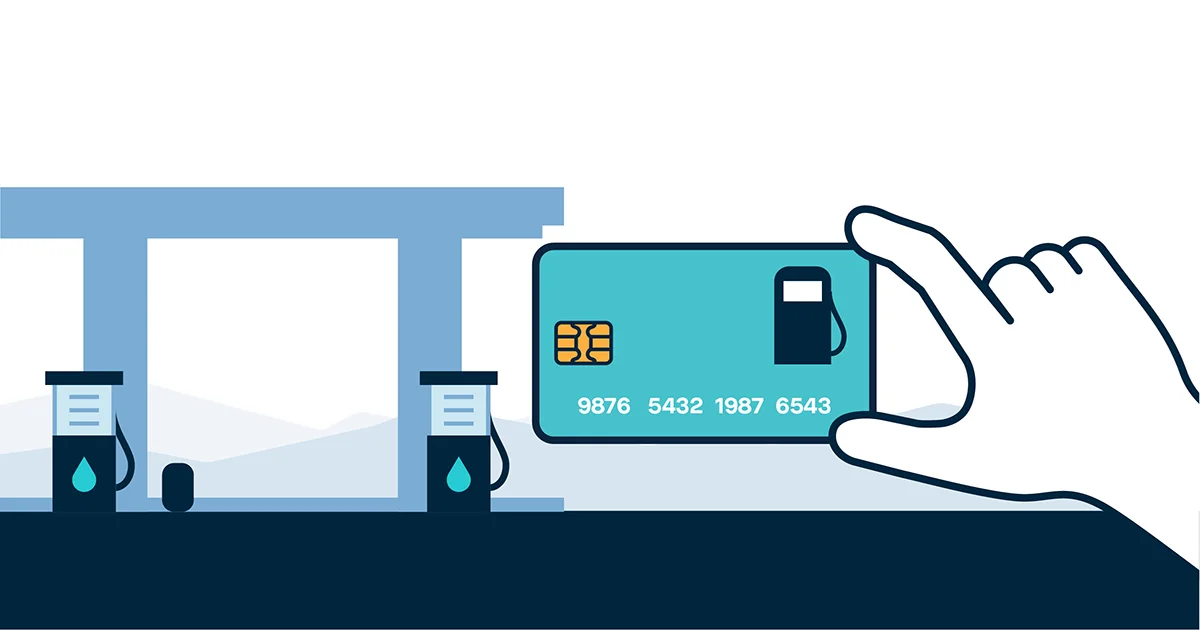A Fleet Manager’s Guide to Fuel Cards for Truckers
October 26, 2020

Get Started with Samsara
Check our pricesKey Takeaways
Fuel cards are a great way for trucking companies to track fuel purchases, set spending controls, get significant fuel discounts, streamline IFTA reporting, and more. In this guide, learn how fuel cards work and what to look for when evaluating the best fuel card for your fleet. Plus, see how you can leverage Samsara’s fuel management tools and integration with FLEETCOR-issued fuel cards, including Comdata, Fuelman, and Universal Premium, to further increase efficiency and reduce fuel costs.
What is a fuel card?
A fuel card (or fleet card) is a payment card that allows truckers to purchase fuel within a network of fueling locations, often at a discounted price. Fuel cards allow fleet managers to track fuel purchases in real time, set spending controls, easily audit expenses, automate IFTA reporting, and more via an online account. Many fuel card programs offer discounted fuel prices or other rebates, helping fleets reduce their overall fuel costs.
How do trucking fuel cards work?
Instead of using cash, a debit card, or a credit card to pay for diesel fuel at fueling locations, truck drivers and independent owner-operators can use a fuel card to pay for fuel purchases and other approved transactions within their fuel card’s network of partnered gas stations and truck stops.
The fuel card provider receives a cut from the gas station (usually 2% to 3% of the fuel purchase) for sending their members to the partnered fuel stations. Sometimes, they will offer discounts off the per-gallon fuel prices. These discounts often differ by fueling location and can change regularly, based on both fuel prices and agreements between the fueling location and fuel card company.
Some fuel card programs offer discounted cash prices at the point-of-sale, whereas others provide monthly rebates. The rebate model can be confusing for drivers who see the regular cash price on their receipt—but both point-of-sale discounts and rebates can provide significant savings for your business.

What are the benefits of fuel cards for trucking companies?
Fuel cards are a great way for trucking companies to track fuel purchases, set spending controls, get significant fuel discounts, streamline IFTA reporting, and more. Here are five main benefits of fuel cards for trucking companies:
Significant fuel savings: Fuel is one of the largest operating costs for commercial fleets across the trucking industry, including large trucking businesses with thousands of commercial trucks and small businesses with just a few vehicles. Many fuel cards offer discounts at in-network fueling locations, so you save a few cents off each gallon—which can really add up. Saving money is one of the main reasons fleets use fuel cards.
Better security and control: Many fleet fuel cards offer adjustable spending controls, including daily transaction limits, daily gallon limits, or postal code restrictions (which only allow the card to function within a specific area of service). These features can help you combat fraud, theft, and unauthorized spending.
Real-time visibility and transparency: Fleet fuel cards help automate tedious accounting. For every fuel purchase made with a fleet fuel card, you can see details like which driver made the purchase, the odometer reading, sales tax, and more. With a fuel card, you no longer have to chase down fuel receipts.
Automated IFTA reporting: Fleet fuel cards automatically track and associate fuel purchases with jurisdiction and vehicle for quarterly International Fuel Tax Agreement (IFTA) reporting. Your IFTA fuel tax reports are automatically prepared and can be downloaded via your fuel card program’s online account.
Ease of use for drivers: Fuel cards are also an easy and efficient payment method for drivers. They function like a credit card, making them simple and fast to use. Plus, with a fuel card, drivers don’t have to carry cash for fuel purchases (or worry about keeping receipts).
What features should you consider when evaluating the best fuel card program for your fleet?
There are lots of different fuel card programs available for trucking companies in the United States—including fuel cards from WEX, Comdata, Fuelman, ExxonMobil, EFS, Arco, and more. Different fuel cards offer access to a different network of partnered gas stations and truck stops, as well as a variety of different features. Here are a few features to consider when evaluating the best fuel card program for your business needs:
Fuel card feature
Description
Discount network
Different fuel card programs offer access to discounts at a different selection of partnered fueling locations and truck stops. To receive the discount, your drivers will need to fuel up at in-network gas stations. If you have a preference for certain gas stations (like Shell or BP) or certain truck stops (like Flying J), make sure to consider each fuel card’s network before choosing one.
Spending controls
Some fuel cards offer the ability to set spending limits, including daily transaction limits, daily gallon limits, or postal code restrictions (which only allow the card to function within a specific area of service). These spending controls can be helpful for guarding against fraud, theft, and unauthorized spending.
Account management tools
Many fuel cards offer additional administrative management tools via an online account, including automated IFTA reports, expense tracking, and integrations with third-party software. Some fuel cards also offer a mobile app, which truck drivers can use to locate the nearest partnered fuel stops and find the lowest fuel prices.
Roadside assistance
Some fuel cards offer roadside assistance as an added perk for choosing their program. Make sure to ask about roadside assistance (and any other perks they offer) when comparing different fleet fuel card programs.
Card fees
Some fuel cards charge monthly fees or transaction fees, whereas others do not. When evaluating different fuel card programs, make sure to ask about any card fees.
Beyond fuel cards, how else can your fleet reduce fuel costs?
Fuel cards are a great way to maximize your fuel purchases, implement spending controls, and generally get more bang for your buck. But to really take control of your fleet’s fuel savings, you also need to monitor and address driving habits. Though seemingly inconsequential, these driving habits can in aggregate have a significant impact on fuel expenses, mechanical repairs, and vehicle lifespan:
Maintaining a steady speed: When a driver’s speed suddenly increases or decreases, the vehicle can consume as much as 20% more fuel. Beyond decreasing your fuel spend, maintaining a consistent speed (at the minimal throttle and with the transmission in the highest gear) will keep your vehicles on the road longer. Optimal speed varies by vehicle type, but is typically somewhere between 35 and 50 MPH.
Engaging cruise control: When used in the right conditions, cruise control can help maintain speed. When a driver is in cruise control, the accelerator is disengaged, which is ideal for certain types of driving that require a steady speed—like freeway driving. However, it’s important to not over-rely on cruise control. It can actually be worse for your vehicle when there’s heavy traffic, winding roads, or icy conditions.
Anticipating traffic: Every time a driver uses the brakes, the vehicle loses forward momentum. By anticipating traffic, pedestrians, and traffic lights, drivers can determine when it’s time to slow down well in advance. Minimizing acceleration and braking while maximizing coasting reduces friction on the engine, reducing fuel consumption, minimizing the need for repairs, and adding to your vehicle’s lifespan.
Reducing unproductive idling: When a driver keeps an engine running, they add more wear on the vehicle and increase overall cost per mile. While it’s necessary for certain types of vehicles to idle in moderation (like while they’re in power take-off mode), fleets can save up to $6,000 per vehicle by minimizing unnecessary idle time.
Staying in the green band: When a vehicle stays in the most efficient RPM—also known as the green band—the engine works less hard. If your driver is operating at a higher RPM, your vehicle will burn fuel faster, and the engine can more easily incur damages that lead to costly maintenance repairs.
Reduce fuel costs and streamline fuel management with Samsara
Many fleets leverage fuel management systems to get real-time visibility into driving behaviors that can affect fuel efficiency, coach employees on efficient driving, and save money. In fact, fuel management is a part of Samsara’s complete fleet management platform, which is trusted by more than 15,000 fleets.
<iframe width="560" height="315" src="https://www.youtube.com/embed/BZFdw3pqE4A" frameborder="0" allow="accelerometer; autoplay; clipboard-write; encrypted-media; gyroscope; picture-in-picture" allowfullscreen></iframe>
Here’s how Samsara can help your fleet reduce fuel costs:
Get real-time fuel data: The Samsara Vehicle Gateway provides real-time visibility into fuel usage, idling time, and more by vehicle and driver.
Improve fuel efficiency: The Samsara Driver Efficiency Report helps you make sense of this data with an efficiency score based on the seven criteria outlined above. With Samsara, you can establish goals for your fleet, coach drivers on fuel efficiency best practices, and reduce fuel costs.
Optimize routing: Samsara makes it easy to identify trends in route performance at a glance. The Samsara Planned vs. Actual Report and Time on Site Report identify trends in planned vs. actual performance, so that you can minimize route delays, optimize overall fleet efficiency, and even further reduce fuel costs.
Streamline IFTA reporting: Samsara's ELD automatically tracks every mile your vehicles travel in each jurisdiction. Simply use Samsara’s Fuel Purchase and IFTA Reports to eliminate extra effort spent on paperwork and seamlessly file your quarterly IFTA tax return.
Integrate with your fuel card: The Samsara FLEETCOR integration allows you to add your fuel purchases from FLEETCOR-issued fuel cards (including Comdata, Fuelman, and Universal Premium) into the Samsara Fuel Purchases Report automatically. With this integration, you can track and manage your fuel data all within one platform.
See for yourself how Samsara can help your fleet improve fuel management and reduce fuel costs. Get a free trial today.
<div class="align-mid-button end"><a id="blog-inline-1" href="/free-trial" title="Get a free trial" class="btn primary-btn btn--blue">Get a free trial</a></div>